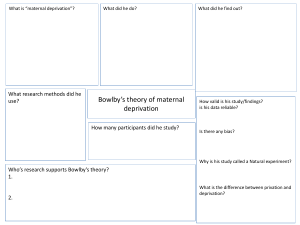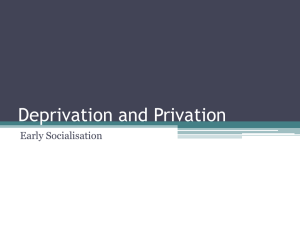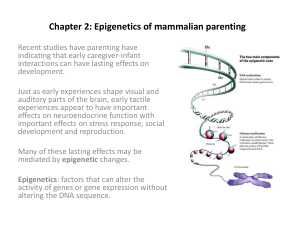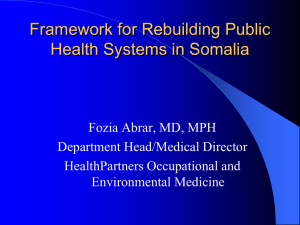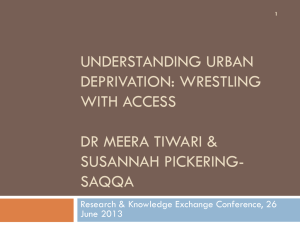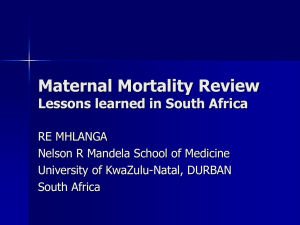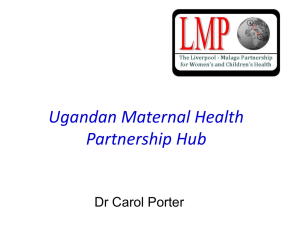Maternal deprivation syndrome - Paediatric Association of Nigeria
advertisement
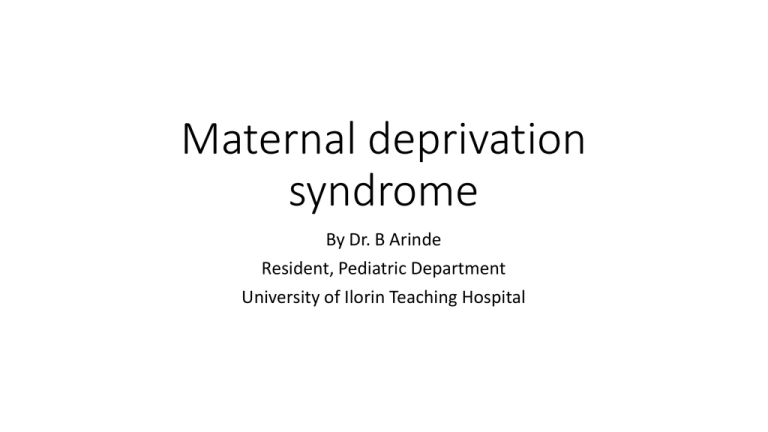
Maternal deprivation syndrome By Dr. B Arinde Resident, Pediatric Department University of Ilorin Teaching Hospital Outline • Introduction • Epidemiology • Causes/risk factors • Features of MDS • Treatment • Complications • Prevention • Prognosis • Conclusion Introduction • Compared to other mammals, the human infant depends on the adult for its survival for a prolonged period • The knowledge of the basic needs of the newborn, and the application thereof by paediatricians, has resulted in a remarkable reduction of neonatal morbidity and mortality. • Less readily apparent among the fundamental needs of the infant are requirements for gentle physical contact, sounds of pleasant and varying tones of the human voice, antigravity play, visual stimuli from the human environment and the more subtle interpersonal communications- in sum, all of those activities ordinarily supplied by a loving mother. Introduction • The term Maternal deprivation dates back to the early work of psychoanalyst John Bowlby, on the effects of separating infants and young children from their mother Core theory- Bowlby theory • He believed the attachment between a caregiver and infant had to happen at least in the first 3 years of the infant’s life. • He called this the CRITICAL PERIOD for attachment. Maternal deprivation theory • Based on Bowlby’s ideas: • Attachment is important for survival • Prototypes for later relationships • Predicts developmental difficulty if the attachment relationship goes wrong: • General developmental problems • Specific issues with social development Core theory- Bowlby theory • MATERNAL DEPRIVATION is the failure of a child to form an attachment in the first 5 years of life, leading to negative psychological effects especially in adulthood • When a child never experiences the opportunity to form any sort of bond it causes PRIVATION Difference between separation and deprivation SEPARATION • A physical disruption of the bond between the parental unit and the child • A suitable replacement of the parental unit (e.g. a surrogate) should not cause any adverse events DEPRIVATION • Loss of the emotional care that is provided by the parental unit • Note the use of the term “parental unit”: can be father or mother • A parent may be physically present and yet provide no emotional support Maternal Deprivation Syndrome (MDS) • A failure to thrive seen in infants and young children and exhibited as a constellation of signs, symptoms, behaviors, usually associated with maternal loss, absence or neglect, and is characterised by lack of responsiveness to the environment and often depression. Maternal deprivation syndrome • Approximately two-third are caused by dysfunctional caregiver interaction, poverty, child abuse and parental ignorance about child care. • Although mother and other primary caregiver may appear concerned, the interplay of physical contact normally seen between mother and child is absent or distorted Local study • Exploratory spatial analysis done in 2003 by O. Uthman • Data collected from Nigeria Demographic and health survey • 6029 children aged 0-59 months • Maternal socioeconomic deprivation index included -mothers with no education -residence in rural area -unemployed mothers -mothers living below poverty level Conclusion; children living in north-east and north-west Nigeria had higher rate of maternal deprivation Maternal deprivation syndrome • Deprivation can occur when -A child lives in an institutionalized setting where he has no major substitute mother and insufficient interaction with a mother figure -He lives with his mother or a permanent substitute mother, where he receives insufficient care and with whom he has insufficient interaction -The child is unable to interact with a mother figure despite the fact that one is present and ready to give sufficient care- this inability being due to repeated break in ties with mother figures Causal /Risk factors • Young parental age • Unplanned/unwanted pregnancy • Maternal death • Absence of father Causal /Risk factors • Wrong child gender! • Low birth weight • Congenital abnormality • Children not breastfed • Chronically ill babies • Children with CP or other neurocognitive problems Causal /risk factors • Low levels of education • Lower economic status/ Affluence • Children from household with high birth order and/or under-5 children greater than 4 • Maternal illness (may be a postpartum complication or debilitating chronic illness) • Absence of support network (family, close friends, or other support) Phases of response to separation/deprivation • Protest; crying and acute distress at loss of mother and by efforts to replace her through limited efforts at child’s disposal • Despair; increasing helplessness, withdrawal and decreasing efforts to regain mother • Detachment; here, the child ‘settles down’ and accepts care from whatever substitute figure available. Symptoms and signs • Subtle to blatant abnormality in interaction between mother and child • Weight loss <5th percentile or an inadequate rate of weight gain • Decreased or absent linear growth ‘falling off’ growth chart Symptoms and signs of MDS • Poor hygiene • Inappropriate clothing • Unusual or overly restricted diet • General lack of care Emotional effects of MDS • A certain amount of maturity and conscious cerebral functioning is necessary in order to produce this syndrome. Thus it is not seen in • young premature infants, • the newborn for the first 2 weeks and; • the severely retarded child Complications • Abandonment • Developmental delay • Severe malnutrition • Mental retardation Complications • Abuse • Neurocognitive disorders • Depression • Delinquency • Sociopathic behavior Treatment • Treatment of failure to thrive is a major undertaking which requires the input of a multidisciplinary team including physicians, nutritionists, social workers, behavioral specialists, and visiting nurses. • Many programs are available for young parents, single parents, and parents having other problems. Referrals should be made as early as possible to appropriate programs. • Helping extended family members recognize that a problem exists and recruiting their help will provide increased support for the mother and infant. Effectiveness of treatment Depends on • Age of child • Clinical symptoms • Severity of problem • Type and duration of deprivation • Adequacy of therapeutic measures available Prevention • Attempt should be made to prevent separation by maintaining the home • Prevent the results of unavoidable separation by well planned foster home • Humanizing institutions of care • Family planning! Prognosis • With early adequate attention and care, full recovery is expected. • However, neglect severe enough to cause failure to thrive can kill the child if it continues without intervention Conclusion • MDS is not only limited to physical maternal loss, it also include the loss of emotional support and feeling of wellbeing that is usually projected from mother to child. • The syndrome is not far from us and we must actively look beneath the surface to identify it and institute timely intervention. Thank you……. References • Kurt G: Maternal deprivation: J. AAP: 18;626, 1956 • Ainsworth M D: The Effects of maternal deprivation; a review of findings and controversy in the context of research strategy: WHO PHP 14 • New York Times: Maternal Deprivation Syndrome • Wikipedia: Maternal Deprivation syndrome
